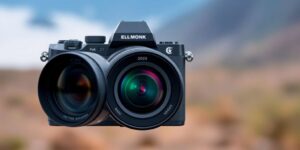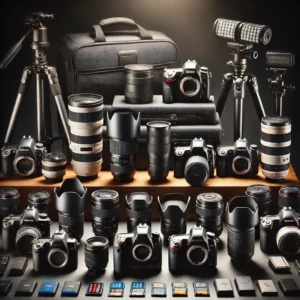A camera tripod is more than just an accessory – it’s a photographer’s best friend. Whether you’re capturing breathtaking landscapes or shooting a sharp portrait, a good tripod provides the necessary stability. There are many types of tripods, from sturdy tripods to handy tabletop tripods, each with its own advantages. This guide will help you find the perfect tripod for your needs and provide tips on care and use.
Key Insights
- A tripod provides stability and allows for sharp images, even with long exposure times.
- There are different types of tripods that offer different advantages depending on the area of use.
- When buying a tripod, material, height, and compatibility with your camera should be considered.
- Regular maintenance and care significantly extend the life of your tripod.
- Accessories such as quick-release plates and tripod bags can enhance the functionality of your tripod.
Why A Camera Tripod Is Indispensable
Stability For Perfect Shots
A tripod is an essential accessory for photographers, especially beginners, providing stability and precision. It enables better shots and is crucial for photography. Without a stable tripod, the image can quickly become blurred, especially with long exposure times or when working with a telephoto lens. A good tripod ensures that your camera remains steady, even when standing on uneven terrain.
Flexibility In Every Situation
With a tripod, you are incredibly flexible. Whether you’re taking a landscape photo at sunrise or shooting a video, a tripod helps you hold the camera in any desired position. You can adjust the height, change the angle, and ensure you always get the perfect shot. Whether you’re a beginner or a pro, the flexibility a tripod offers is unbeatable.
Discover Creative Possibilities
A tripod opens up new creative possibilities. You can try long exposures where the world around you is in motion while your subject remains sharp. Or you can experiment with time-lapse shots and see how scenes change over hours. With a tripod, you can also photograph at night and capture the stars. Let your creativity run wild and discover new techniques that would hardly be possible without a tripod.
A tripod is not just a tool, but an extension of your creative vision. It gives you the freedom to try things you might not have thought possible before.
The Different Types Of Camera Tripods

Tripods For Stability
Tripods are the classic among tripods. They offer excellent stability and are ideal if you want to use long exposure times or heavy lenses. These tripods are available in various materials such as aluminum and carbon fiber, making them robust and durable. They are perfect for landscape and studio photography as they stand stable even on uneven terrain.
Monopods For Mobility
Monopods are the lightweight, portable siblings of tripods. They are ideal when you need to be on the move quickly, such as at sporting events or while traveling. Although they are not as stable as tripods, they still offer good support to reduce camera shake. Another advantage is that they take up less space and are easier to transport.
Tabletop Tripods For Compactness
Tabletop tripods are small, lightweight, and perfect for use on tables or other elevated surfaces. They are ideal for vloggers or when you want to take close-up shots. These tripods are extremely compact and fit in almost any bag, making them a perfect companion for spontaneous photo sessions. Despite their size, they offer surprisingly good stability for lightweight cameras or smartphones.
What To Look For When Buying A Camera Tripod
Material And Workmanship
If you’re looking for a new tripod, you should definitely pay attention to the material. Aluminum and carbon are the most common options. While aluminum is robust and more affordable, carbon offers a lighter alternative that is particularly practical for travel. A well-made tripod can make the difference between a stable shot and a shaky image. Make sure the joints and locks are well-made and easy to operate.
Height Adjustability And Flexibility
Another important criterion is height adjustability. A good tripod should be able to flexibly adapt to different heights so that you can easily take both low-angle and high-angle shots. Some models even offer a reversible center column, which opens up additional creative possibilities. Check if the tripod offers a sufficient working height for your needs.
Compatibility With Your Camera
Not every tripod is compatible with every camera. You should ensure that the tripod has the right mounting plate for your camera. Especially with heavier cameras, such as DSLRs, it is important that the tripod offers the necessary load capacity. When buying a tripod, it is important to pay attention to high quality. An expensive camera should not be mounted on a cheap tripod. Stability is crucial to achieve optimal results.
A high-quality tripod is an investment in your photography. It’s worth spending a little more to get a model that will serve you well for a long time and keep your camera safe.
Tips For The Care And Maintenance Of Your Camera Tripod
Cleaning And Storage
A clean tripod is a happy tripod. Regular cleaning prevents dirt and dust from affecting the mechanics. Use a soft, lint-free cloth to wipe the surface. For hard-to-reach areas, compressed air can be helpful to remove dust and particles. Be sure to treat water spots immediately to prevent corrosion. After each use, especially outdoors, you should thoroughly clean and store the tripod dry.
A well-maintained tripod lasts longer and works more reliably.
Regular Checking Of Screws
It is important to regularly check all screws and connections. These can loosen during transport or frequent use. Tighten them if necessary to ensure stability and safety. Once a month is often enough, but with intensive use, it may be necessary more often.
Protection From Weather Conditions
A tripod is often exposed to wind and weather. Protect it with a suitable bag or cover when transporting it. Avoid leaving the tripod in damp environments for extended periods. If it does get wet, dry it thoroughly before storing it. This prevents rust and extends the life of your tripod.
Accessories That Enhance Your Camera Tripod
Quick Release Plates For Flexibility
Quick release plates are a must for anyone who frequently switches between different cameras or shooting angles. With these plates, you can quickly detach and reattach your camera from the tripod without constantly turning the screws. This not only saves time but also spares your nerves. Make sure the quick release plate is compatible with your tripod head.
Tripod Bags For Easy Transport
A tripod without a bag? That’s like a fish without water. Tripod bags not only protect your valuable equipment from dust and scratches but also make transport easier. Whether you’re heading to the next shoot or going on a short hike, with a good bag, you always have your tripod ready and safely stowed. It’s practical if the bag also has additional compartments for accessories.
Additional Mounts For More Options
Sometimes you need more than just the camera on the tripod. Additional mounts allow you to attach other accessories such as microphones, lights, or even a smartphone. This can take your shots to a new level and give you more creative freedom. Consider what you often need additionally and then choose the appropriate mounts.
A well-equipped tripod can make the decisive difference when it comes to taking the perfect picture or video. Let yourself be inspired by the variety of accessories and find out what best suits your needs.
Common Mistakes When Using Camera Tripods

Incorrect Setup Of The Tripod
When photographing or filming, it can quickly happen that the tripod is not set up correctly. A common mistake is placing it on uneven ground without aligning the legs correctly. This can cause the camera to shake or even tip over. Make sure to spread the legs evenly and adjust the height so that the tripod stands stable.
Ignoring The Load Capacity
Many underestimate the importance of a tripod’s load capacity. Each model has a maximum load capacity that should not be exceeded. If you use a heavy camera or additional equipment, be sure to check if your tripod can support the weight. Otherwise, you risk the tripod tipping over or being damaged.
Insufficient Securing Of The Camera
Another common mistake is not securing the camera properly on the tripod. Make sure the quick release plate is firmly seated and all screws are tightened. Negligent securing can cause the camera to fall and be damaged.
It’s often the small details that make the difference. A securely set up tripod and a correctly attached camera give you the freedom to fully focus on your creativity.
The Best Brands For Camera Tripods
If you’re looking for a camera tripod that is both robust and versatile, then you’re in the right place. Some brands have particularly stood out in the world of tripods. Let’s take a look at the best ones.
Manfrotto For Professionals
Manfrotto is probably the epitome of professional tripods. This brand has made a name for itself by offering high-quality and durable products that photographers worldwide appreciate. Manfrotto tripods are known for their stability and the variety of accessories they offer. Whether you have a heavy telephoto lens or a lightweight camera, Manfrotto has the right model for you.
Benro For Versatility
If you’re looking for a tripod that is both lightweight and flexible, then Benro is an excellent choice. This brand offers a wide range of tripods suitable for various applications. From travel tripods that fold compactly to stable models for studio use – Benro has something for everyone. Their models that can be converted into monopods are particularly popular.
Dörr For Beginners
Dörr is the perfect brand for those just entering the world of photography. Dörr tripods are not only affordable but also easy to handle. They offer good stability and are ideal for hobby photographers looking for a solid base for their camera. Especially the Dörr Pocket Tripod FLEXI MINI is a hit among compact tripod lovers.
Conclusion
So, that’s it! Now you know everything you need to know about camera tripods. Whether you’re a pro or a hobby photographer, the right tripod can make a difference. There are so many options out there, from super lightweight travel tripods to sturdy models for the studio. Remember, the best tripod is the one that suits your needs and style. So, try a few out, experiment, and find the perfect one for you. Have fun photographing and filming!
Frequently Asked Questions
Why is a tripod important for my camera?
A tripod ensures that your camera remains stable, especially in low light conditions or with long exposure times. This results in sharper and clearer images.
What types of tripods are there?
There are different types of tripods: tripods for high stability, monopods for more freedom of movement, and tabletop tripods for use on small surfaces.
How do I properly care for my camera tripod?
Regularly clean your tripod from dust and dirt, check the screws and joints, and protect it from extreme weather conditions.
What should I consider when buying a tripod?
Pay attention to the material, workmanship, and compatibility with your camera. The height and flexibility of the tripod are also important factors.
Can I use a tripod for videos as well?
Yes, many tripods are suitable for both photo and video recordings. Make sure the tripod has a stable head for smooth pans.
What accessories are useful for a tripod?
Quick release plates, tripod bags, and additional mounts can make using your tripod even more versatile and comfortable.



